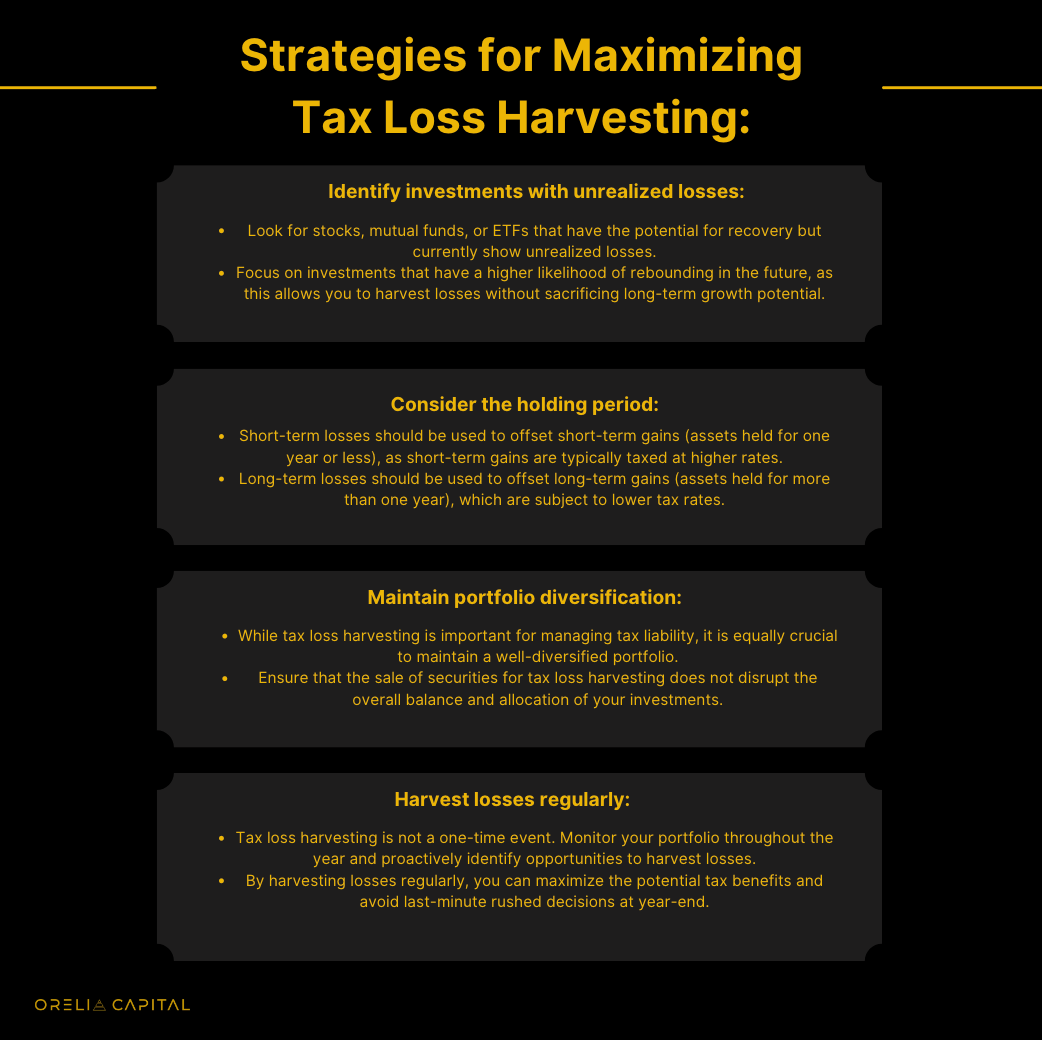Tax Loss Harvesting

Introduction to Tax Loss Harvesting:
Tax loss harvesting is a powerful strategy investors use to optimize their tax liability and potentially increase after-tax returns. This approach involves strategically selling investments that have experienced a decline in value, thereby realizing capital losses. These losses can then be used to offset capital gains, reducing the overall taxable income and potentially lowering the investor's tax bill.
The concept behind tax loss harvesting is to take advantage of market downturns or underperforming investments to generate losses that can be used as a tax advantage. By selling these investments at a loss, investors can create a paper loss, which can be used to offset capital gains realized on other investments. This can help to reduce the investor's taxable income and, in turn, lower their tax liability.
Benefits of tax loss harvesting:
- Reducing taxable income: By offsetting capital gains with capital losses, tax loss harvesting helps reduce the overall taxable income, potentially putting you in a lower tax bracket.
- Lowering tax liability: By utilizing losses to offset gains, you can lower your tax liability, resulting in potential tax savings.
- Potential for long-term tax savings: By strategically implementing tax loss harvesting over multiple years, you can accumulate losses that can be carried forward to offset future gains, resulting in long-term tax savings.
- Minimizing capital gains taxes: By offsetting capital gains with capital losses, you can minimize the taxes owed on the gains, allowing you to keep more of your investment returns.
- Risk management: Tax loss harvesting enables investors to mitigate the impact of market downturns by proactively realizing losses and using them to offset gains.
- Improving after-tax returns: By optimizing your tax situation through tax loss harvesting, you can enhance your after-tax investment returns and potentially increase your overall wealth accumulation.
Potential Risks and Limitations:
- Market rebound risk: Selling investments at a loss to harvest tax benefits may prevent you from benefiting from potential future appreciation if the market rebounds. It's important to carefully assess the long-term prospects of the investment before deciding to sell for tax purposes.
- Transaction costs and fees: When executing tax loss harvesting, consider the transaction costs and fees associated with selling and buying securities. These expenses can impact the overall effectiveness of the strategy. Evaluate whether the potential tax savings outweigh the costs incurred.
- Impact on long-term investment strategy: Tax loss harvesting should align with your overall investment objectives. Assessing whether selling securities solely for tax purposes disrupts your long-term investment strategy is crucial. Balance the tax benefits with the potential impact on your portfolio's growth and asset allocation.
- Wash sale limitations: The IRS prohibits repurchasing "substantially identical" securities within 30 days before or after the sale to claim tax losses. This rule restricts immediate reentry into the same or similar investments. Consider alternative investment options during the wash sale period to maintain exposure to the desired market sector or asset class.
- Potential tax law changes: Tax laws can change, and the benefits and limitations of tax loss harvesting may be subject to revisions. Stay informed about potential legislative updates and consult with a tax professional to understand the current tax regulations and implications.
💡Capital gains: These are profits generated from the sale of investments at a higher price than their purchase price. Depending on the holding period, they can be categorized as either short-term or long-term gains.
💡Short-term gains: These occur when investments are held for one year or less before being sold. They are subject to ordinary income tax rates, which can be significantly higher than long-term capital gains tax rates.
💡Long-term gains: Investments held for more than one year before being sold result in long-term capital gains. These gains are generally taxed at lower rates than ordinary income, incentivizing investors to hold investments for the long term.
💡Carryover losses: If capital losses exceed capital gains, the excess losses can be carried forward to future years to offset future capital gains or other types of income.

Timing Considerations
Timing is a critical factor in executing tax loss harvesting strategies effectively. The following points highlight vital considerations to maximize the benefits of this tax-saving technique:
- Year-end tax planning: Conduct a thorough review of your investment portfolio towards the end of the year. Assess your capital gains and losses to determine if tax loss harvesting can be utilized to offset gains and reduce your tax liability for the current tax year. By doing this before December 31st, you can strategically implement any necessary transactions.
- Market volatility and timing: Tax loss harvesting presents an opportunity to sell investments at a loss. Therefore, it's advantageous to execute this strategy during periods of market downturns or heightened volatility. When markets experience declines, the value of certain securities may be lower than their original purchase price, providing an opportunity to realize losses for tax purposes. However, it's essential to strike a balance and not let the pursuit of tax savings hinder your long-term investment strategy. Careful consideration must be given to the potential for future market rebounds and the risk of missing out on potential gains.
- Beware of wash sale rules: The Internal Revenue Service (IRS) has established wash sale rules to prevent investors from artificially creating losses without changing their actual investment positions. According to these rules, if you sell a security at a loss, you cannot repurchase a "substantially identical" security within 30 days before or after the sale if you want to claim the tax loss. Violating this rule renders the loss ineligible for tax purposes. Therefore, it's crucial to be mindful of the timing and avoid triggering wash sales inadvertently.

Tax Implications:
- Short-term losses offset short-term gains: When executing tax loss harvesting, short-term capital losses can be used to offset short-term capital gains. This helps reduce the tax liability on gains realized within one year.
- Long-term losses offset long-term gains: Similarly, long-term capital losses can be used to offset long-term capital gains. By doing so, investors can potentially lower their tax liability on gains realized after holding an investment for more than one year.
- Utilizing excess losses: If the total amount of losses exceeds the gains in a given year, investors can use the excess losses to offset ordinary income, subject to certain limitations. This can help further reduce their overall taxable income.
- Carrying losses forward: If the losses exceed the allowable deduction for a given year, the unused losses can be carried forward to offset gains in future years. This allows investors to utilize the losses over an extended period and potentially maximize their tax benefits.
- Consult a tax professional: Due to the complexities of tax laws and individual circumstances, it's recommended to consult a qualified tax professional to fully understand the tax implications of tax loss harvesting and ensure compliance with applicable regulations.
Incorporating these strategies into your investment approach can enhance tax efficiency, potentially reduce your tax liability, and align your portfolio with your financial goals. As with any financial decision, it is recommended to consult a professional to seek the best available advice.
Resource Hub
How to take advantage of Tax Loss Harvesting?

We hope you enjoyed this edition of our newsletter. If you found it helpful, please consider sharing it with others who might benefit from this information.
At Orelia Capital, we believe that feedback is a gift. Your feedback can help us improve our content and provide more value to our readers.





